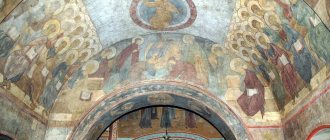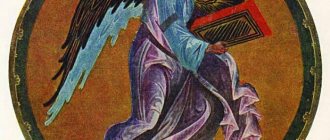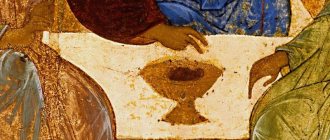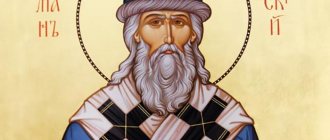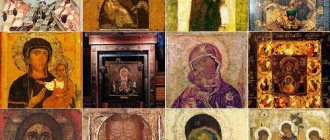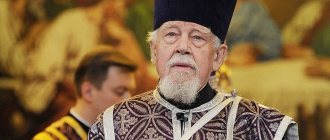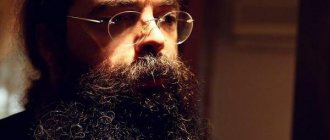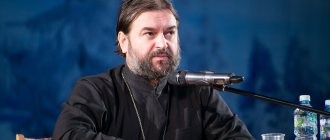At the height of summer, on July 17, the Orthodox Church celebrates the day of St. Andrei Rublev. The artist created icons, painted temples, and taught art to students. He completely changed the style and rules of creating images. Several centuries have passed. It was possible to establish the exact authorship of only some of the works. Many artists began to paint in a similar style. There are some icons that are considered the best in the collection left by Andrei Rublev and are of great importance in the development of the creativity of the Church in Rus'.
How then can we talk about the special “style of Andrei Rublev”?
It is indeed very difficult to talk about Rublev's style. But here you need to keep one nuance in mind.
Icon painting is fundamentally anonymous; authors almost never put their names on icons. And, nevertheless, the name of Andrei Rublev was remembered. It appears in the chronicles; its works were appreciated and collected by the founder of the Volokolamsk monastery, Rev. Joseph of Volotsky. This means that Rublev’s fame was great, his contemporaries noted him, they saw that he was not a copyist, not an imitator of Byzantine masters.
Andrei Rublev was not only an artist, he was a theologian, and his contemporaries appreciated this.
Painting by Andrei Rublev of the Spassky Cathedral of the Andronikov Monastery, book miniature ca. 1592
In the era when the Monk Andrew lived (and this is the end of the 14th - beginning of the 15th centuries), there was nothing shameful in copying icons of someone else's writing. Icon painters often made copies of other icons - interpretations of the original sample, often quite free, but always related to the original.
But in Rublev we find something completely different. Theological novelty, theological courage.
The range of artistic monuments, one way or another connected with Andrei Rublev, is very different from the rest of the art of that era. The way Rublev wrote “Trinity”, it had never been written before. Icon painters traditionally turned to the plot of “Abraham’s Hospitality”: they depicted, in addition to the three Angels, Abraham and Sarah, a set table, a slaughtered calf, etc.
"Zvenigorod rank". Face of the Savior
In 1918, in a woodshed near the Zvenigorod Assumption Cathedral “on Gorodok,” three Deesis icons were discovered, which were attributed to I. Grabar based on a stylistic analysis of Rublev’s brush.
Later, researchers almost unanimously accepted the attribution of Grabar, despite the fact that Rublev’s authorship was never documented. The “Zvenigorod rite” includes three icons: “Savior”, “Archangel Michael” and “Apostle Paul”.
The most perfect, undoubtedly, is the image of the Savior, whose calm, thoughtful and surprisingly benevolent gaze is directed at the viewer. Hope, the promise of intimacy and heartfelt participation, along with sublime, ideal beauty, which is infinitely removed from the world of ordinary people - the Russian icon painter managed to perfectly embody all this.
Icon "Hospitality of Abraham"
The time of creation is the 16th century, the place of storage is the Yaroslavl State Historical, Architectural and Art Museum-Reserve. The plot of the icon is based on the story of the Book of Genesis about the visit to the house of Abraham and his wife Sarah by the Lord in the form of three husbands. Abraham treated the visitors, ordering Sarah to prepare unleavened bread and the servant to slaughter the calf, and received a promise from the Lord that he would have a son in whom all nations would be blessed (Gen. 18:1-19).
Trinity. Icon of Andrei Rublev. 14254
Rublev created an icon that focused not on everyday details, but on theology. Three Angels are the image of the Eternal Council of Persons of the Holy Trinity, at which the fate of man is decided. And the cup is an image of the Holy Eucharist...
In addition, Rublev’s “Trinity” is a phenomenon of amazing harmony and beauty. God appears here in beauty and harmony. Beauty is one of the names of God. And there is deep theology in this too.
Rublev's world - a new era in art
The end of the 14th and beginning of the 15th centuries were marked in the history of the Russian state by the flowering of art and science. The country has become a powerful socio-political organization. Having united to fight the Tatars, the principalities became a large and strong state. In Moscow and other large cities, centers of education were formed, book depositories were created, scribes worked on copying and duplicating chronicles and books.
Every year new architects, writers, and painters appeared. The greatest temples were founded and erected. Their decoration preserved the traditions of old paintings, but at the same time it looked completely new and natural.
Andrei Rublev created a completely different style of icon painting. His saints had Slavic, Russian faces, the images were natural, three-dimensional, proportional. Bright colors appeared on the images, carrying additional information. Now, from paintings and icons, instead of flat Greek faces, faces with soulful eyes looked at the laity, in which one could read the mood and difficult fate of the saints.
Stone cathedrals and wooden churches were built throughout the Russian land. Andrei Rublev, Feofan the Greek and other masters of the new school, with numerous students and apprentices, were in great demand. The artists worked in different styles, but adhered to the same concept. As a result, the Byzantine and Russian schools, respecting the framework prescribed by iconography, raised art to new heights.
WE RECOMMEND: Technique for painting icons.
Andrei Rublev's brushes include many works of different formats. He painted walls and domes of churches, created iconostases and single icons, and painted miniatures on biblical themes. The great master's disciples tried to imitate him in everything. As a result, some of the works are conventionally classified as Rublev’s; their creator could be the great artist himself or his students.
Where else do we find Rublev’s “handwriting”?
It is very likely that Rublev owns part of the paintings in the Assumption Cathedral of Vladimir - frescoes depicting the Last Judgment. And in these frescoes we also see the deep theological understanding characteristic of Rublev.
There is nothing scary or frightening in his Last Judgment! The main thing in this whole composition is the appearance of Christ. Christ is coming, and the Church is meeting Him - this is the key meaning of all this large-scale work. The spirit with which it is permeated is surprisingly peaceful. Angels talk peacefully with the apostles; The Apostle Paul leads the righteous to heaven, waving a charter. This is what the sheets of papyrus were called in ancient times. – Approx. ed. with the inscription “Come with me,” as if inviting everyone to follow him. Apocalyptic paintings fit in one single circle: here Andrei Rublev depicted four animals: a lion, a bear, a leopard and an unnamed “fourth beast, terrible and terrible” (Dan 7 : 1-7). – Approx. ed. from the vision of the prophet Daniel, symbolizing the four kingdoms of the last times. It is very characteristic that he presented the kingdom of the Antichrist in the form of a hyena, a nasty dog, more vile than scary, whose place is somewhere in the corner.
"The Last Judgment." Face of Christ
Thousands of people from all over the world come to Vladimir to visit the Assumption Cathedral and see the unforgettable frescoes created in 1408 by Daniil Cherny and Andrei Rublev. This painting today is the only monument of Rublev’s art confirmed in chronicles. Executed in the Byzantine tradition, the painting of the Second Coming of Christ is reinterpreted. The central figure of the composition is undoubtedly Christ, who seems to descend from heaven to the viewer waiting for Him. He seems surprisingly close, his face is bright and gentle. He brings peace and salvation to people.
The presence of each participant in the picture is justified and symbolic: the Angel, twisting the heavens, like a scroll, announces the approach of Judgment; the prepared Throne with the instruments of the Passion recalls the atoning sacrifice of the Savior; the figures of the ancestors symbolize the bonds of original sin.
Under the figure of Christ are the Mother of God and the Forerunner, who remind the viewer of the incessant prayer of the patron saints of the human race. Their prayer seems to be continued by the faces of the apostles, who look benevolently and at the same time sternly at the viewer. Almost for the first time in Russian art, the idea of a righteous and merciful Court was embodied in this picture in such a perfect artistic form.
Gospel Khitrovo. Face of the Evangelist Matthew
Another hypothetical monument of Rublev's writing - miniatures of the altar Gospel of Khitrovo - stand out in the heritage of the icon painter. This unique example of a manuscript, kept today in the collection of the Russian State Library, was presumably made in one of the best workshops of the Grand Ducal Moscow at the turn of the 14th-15th centuries.
The text of the manuscript is accompanied by eight miniature front illustrations depicting the evangelists and their symbols. The style of the miniatures suggests that they were painted by Theophanes the Greek, Daniil Cherny and Andrei Rublev, while the names of the last two icon painters are most often mentioned.
There is no consensus among scientists: for example, G. Vzdornov believes that they all belong to the brush of Cherny, and O. Popova convincingly proves the opposite - they were all created by Rublev. The symbolic image of the Evangelist Matthew is most often attributed to Rublev. The tilt of the neck, the outline of the head of fluffy hair, and the type of face are very close to the Rublev images created by the master in the Vladimir frescoes.
However, Angel's gaze is harsher. In clothes flying through the air with the Gospel in his hand, he quickly moves towards the viewer, wanting to quickly convey the Word of God to him. Despite the fact that it is often not possible to accurately establish the authorship of the holy icon painter, our country has a grandiose heritage, including unsurpassed examples of ancient Russian culture.
Biography
For the Russian people and world Orthodoxy, the icon painter Andrei Rublev became a symbol of art and a certain standard of the Russian person, the greatness of the Slavic spirit. The master’s icons and frescoes breathe harmony with the universe, reminiscent of a lost paradise, happiness and serenity.
Icon painter Andrei Rublev
Fans compare the icon painter’s work with the poetry of Alexander Pushkin. It is just as thorough, eternal and brilliant. Peering into the faces of the Rublev saints, you see self-sacrifice, beauty and greatness of man. Andrei Rublev understood the essence and spirit of faith in God, so the Russian Orthodox Church canonized the icon painter, canonizing him among the reverend saints.
Death and memory
The icon painter died in the late autumn of 1428 from the plague epidemic that was raging in Moscow. Death overtook Andrei Rublev in the Andronikov Monastery, where in the spring he, together with Daniil Cherny, worked on his fourth work - the frescoes of the Spassky Cathedral (they have not survived). Soon after the icon painter his faithful colleague and friend left. According to legend, before his death Andrei Rublev appeared to Daniil Cherny, “in joy calling him to heaven.” To Daniel, Andrei’s appearance seemed joyful and bright.
Monument to Andrey Rublev
The icon painter was buried near the bell tower of the Spassky Cathedral. In 1988, the artist was canonized and canonized, establishing July 17 as his memorial day. In the mid-1990s, archaeologists discovered the ancient throne of the Spassky Cathedral, and next to it the relics. They were attributed to the famous master, but the statement was soon recognized as erroneous.
Central Museum of Ancient Russian Culture and Art named after Andrei Rublev
Researchers call the generally accepted date of the artist’s death erroneous, claiming that Andrei Rublev died at the end of January 1430. Architect P. D. Baranovsky insists on the date January 29, 1430. The architect assured that it was precisely this that was carved on Rublev’s tombstone before it was lost. The Andrei Rublev Museum of Ancient Russian Art was built on this site, the founder of which was the architect Pyotr Baranovsky.
In the late 1940s, a reserve appeared in the Spaso-Andronikov Monastery. The great Rublev is also remembered in Vladimir: a monument to the icon painter stands at the entrance to the park named after A.S. Pushkin. A crater on Mercury was named in honor of the saint, a series of commemorative coins and a postage stamp were issued. In 1966, the film drama “Andrei Rublev” was shot at the Mosfilm film studio by director Andrei Tarkovsky. The original title of the painting, “The Passion of Andrew,” was abandoned. The film consists of eight short stories, in which the turmoil of the Middle Ages is described through the eyes of the monk Andrei Rublev. The artist was played by actor Anatoly Solonitsyn.
List of icons of the Mother of God of Vladimir. Face of the Virgin Mary
Despite the obvious discovery of features of Rublev's writing, the author of the icon could not have been Rublev himself, but someone from his inner circle. Grabar unequivocally states that the work was made by a great master: “Everything here is from Rublev - the cold bluish overall tone, the character of the drawing, facial features, with the slight hump of the nose typical of Rublev, graceful hands, the beautiful silhouette of the entire composition, the rhythm of lines and harmony colors."
The traditional Byzantine prototype - the Mother of God holding Her Son on her right hand and tenderly bending towards Him - was realized with some, most likely deliberate deviations. This is especially true for the figure of the Mother, since the Child is reproduced exactly according to the Byzantine model. In the figure of the Mother of God, the anatomical correctness of the forms is violated, first of all, the bend of the neck, which allows the Mother’s face to come as close as possible to the face of Jesus. Their gazes meet.
The hands of the Virgin Mary are amazingly depicted, wide open in a prayerful gesture. The Mother's face is covered with a maforium, which, like a dome, extends over the Baby, protecting and calming him. And, of course, one is struck by Rublev’s tranquility, purity, absence of sorrow and suffering, filled with silence, peace and a feeling of love in the face of the Mother of God. You can see the icon in the exhibition of the Vladimir-Suzdal Museum-Reserve.
"Zvenigorod rank". Face of Archangel Michael
The second icon of the “Zvenigorod rank” was the image of Archangel Michael. His face, turned to the Savior, seems to echo him with thoughtful meekness and tranquility of his gaze.
This image refers us to the Angels of the Holy Trinity, and not only in its humility, but also in its visual similarity - a long, flexible, slightly elongated neck, a cap of thick curls, a bowed head. The third icon, “Apostle Paul,” was made in a manner different from Rublev’s, so a number of researchers believe that this face would have been created by another master, for example, Rublev’s long-time associate, Daniil Cherny. You can see the icons of the Zvenigorod rank in the Tretyakov Gallery.
